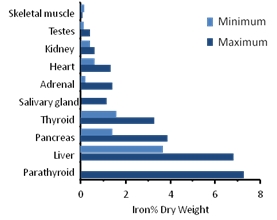What is iron overload?
Iron overload is the accumulation of excess iron in the body. People who receive multiple blood transfusions in the course of treatment for certain diseases are at particular risk of iron overload as the body has no natural mechanism for excreting iron. One unit of transfused red cells delivers approximately 250mg of iron to the body. People with thalassaemia, sickle cell anaemia, Diamond Blackfan anaemia and myelodysplastic syndrome may receive regular blood transfusions, resulting in a need to monitor total body iron, and where appropriate, to remove it through chelation therapy. More recently, iron overload is becoming increasing recognised as a complication in cancer survivors who received multiple blood transfusions as part of their cancer therapy. To read more about the application of FerriScan in this setting please refer here: Iron Overload in Cancer Survivors.
Iron overload can also be caused by excessive absorption of iron from the diet, as occurs in the hereditary disease haemochromatosis.
Clinicians managing these conditions require a complete picture of a patient’s body iron stores to inform their decisions on treatment options.
Accurate monitoring of liver iron concentration (LIC) provides essential information in the prevention of iron-related complications and premature death in iron overloaded patients.

Modell B. Br Med Bull. 1976;32:270
This graph shows the organs in which iron deposition occurs when there is excess iron in the bloodstream.
The liver is the primary site of iron storage in the body.
Why Monitor Liver Iron?
Deposits of iron in tissues cause organ damage, and accumulation occurs primarily in the liver. Once the iron-binding capacity of the liver has been exceeded, deposition occurs in other organs, such as the heart. This causes a greater risk of cardiac complications and premature death.
Therefore, monitoring of liver iron concentration provides an early warning of potential cardiac iron loading and its attendant health implications.
Update on Imaging: Detection of Iron in Liver in Heart – Webcast and Powerpoint presentation by Professor Tim St Pierre – from European Society of Haematology website: 'The Curriculum in Iron Metabolism and Related Disorders'
Why Monitor Cardiac Iron?
The deposition of cardiac iron has profound implications for patient health and indicates that urgent measures must be taken to reduce body iron loading.
An analysis of both liver and cardiac iron therefore enables clinicians to get a more complete picture of body iron loading, to appraise the immediate health risks to the patient and inform their decisions on treatment options.